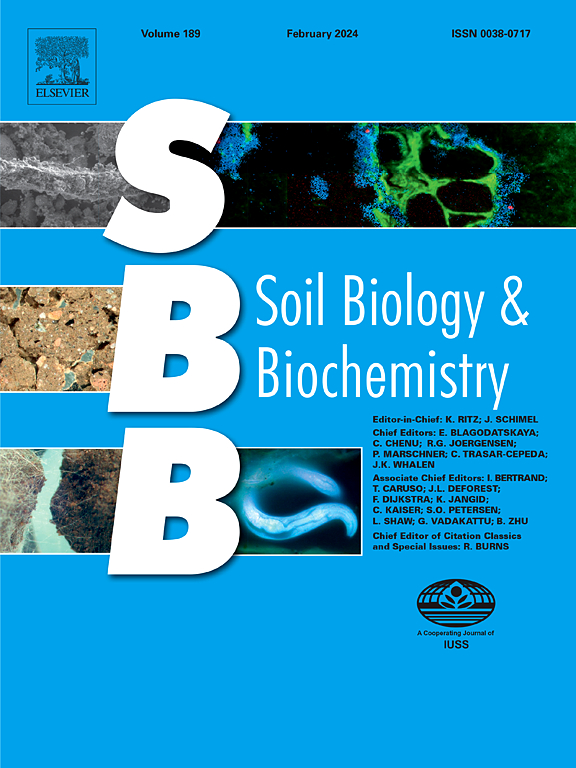Root exudate lipids: Uncovering chemodiversity and carbon stability potential
IF 10.3
1区 农林科学
Q1 SOIL SCIENCE
引用次数: 0
Abstract
Root-derived carbon has been shown to contribute more to soil carbon stocks than aboveground litter. Yet the molecular chemodiversity of root exudates remains poorly understood due to limited characterization and annotation. In this study, we characterized the molecular chemodiversity and production of metabolites and lipids in root exudates from field grown mature tall wheatgrass (Thinopyrum ponticum). We discovered a diversity of lipids, including substantial levels of triacylglycerols (∼19 μg/g fresh root per min), fatty acyls, sphingolipids, sterol lipids, and glycerophospholipids, some of which have not been previously documented in root exudates. By integrating tandem mass spectral library searching and deep learning-based chemical class assignment, our metabo-lipidomics approach significantly expanded the known molecular diversity of root exudates. Rates of lipid derived carbon production were approximately double that of polar metabolites (lipids: 81.52 ± 13.81 vs polar metabolites: 38.41 ± 5.93 μg C g−1 fresh root mass min−1) with an order of magnitude higher carbon to nitrogen ratios (lipids: 459 ± 90 vs polar metabolites: 14.40 ± 0.58). Exudate lipids displayed highly negative nominal oxidation state of carbon (−1.182 to −1.909), indicating that these compounds may be less favorable for microbial decomposition. Together our results suggest the potential of root exudate lipids to contribute to stable carbon pools in soil, supporting long-term carbon storage. This work advances understanding of plant-derived lipid inputs to soil and underscores the need for future studies on the functional roles of lipids in shaping root-microbe-soil interactions, microbial activity, soil structure, and nutrient availability – contributing to soil health.
根系分泌物脂质:揭示化学多样性和碳稳定性潜力
根源碳已被证明对土壤碳储量的贡献大于地上凋落物。然而,由于有限的表征和注释,根分泌物的分子化学多样性仍然知之甚少。在本研究中,我们对田间成熟高麦草(Thinopyrum ponticum)根系分泌物的分子化学多样性和代谢物及脂质的产生进行了研究。我们发现了多种脂质,包括大量的三酰基甘油(~ 19 μg/g每分钟新鲜根)、脂肪酰基、鞘脂、固醇脂和甘油磷脂,其中一些以前没有在根渗出物中记录过。通过整合串联质谱库搜索和基于深度学习的化学分类分配,我们的代谢脂质组学方法显着扩展了根分泌物的已知分子多样性。脂质衍生碳的产生率大约是极性代谢物的两倍(脂质:81.52±13.81 vs极性代谢物:38.41±5.93 μg -1鲜根质量min-1),碳氮比高一个数量级(脂质:459±90 vs极性代谢物:14.40±0.58)。渗出的脂质显示出高度负的碳标称氧化态(-1.182至-1.909),表明这些化合物可能不太有利于微生物分解。综上所述,我们的研究结果表明,根系分泌物脂质有助于土壤中稳定的碳库,支持长期的碳储存。这项工作促进了对植物源性脂质输入土壤的理解,并强调了脂质在塑造根-微生物-土壤相互作用、微生物活性、土壤结构和养分有效性方面的功能作用的未来研究的必要性,这些作用有助于土壤健康。
本文章由计算机程序翻译,如有差异,请以英文原文为准。
求助全文
约1分钟内获得全文
求助全文
来源期刊

Soil Biology & Biochemistry
农林科学-土壤科学
CiteScore
16.90
自引率
9.30%
发文量
312
审稿时长
49 days
期刊介绍:
Soil Biology & Biochemistry publishes original research articles of international significance focusing on biological processes in soil and their applications to soil and environmental quality. Major topics include the ecology and biochemical processes of soil organisms, their effects on the environment, and interactions with plants. The journal also welcomes state-of-the-art reviews and discussions on contemporary research in soil biology and biochemistry.
 求助内容:
求助内容: 应助结果提醒方式:
应助结果提醒方式:


